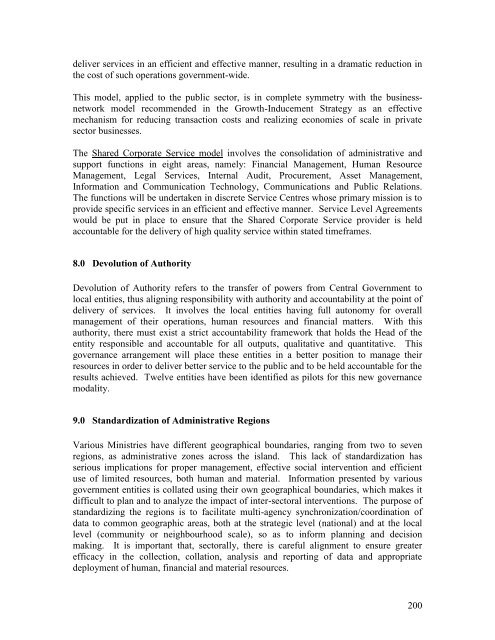PIOJ Growth-Inducement Strategy - Planning Institute of Jamaica
PIOJ Growth-Inducement Strategy - Planning Institute of Jamaica
PIOJ Growth-Inducement Strategy - Planning Institute of Jamaica
Create successful ePaper yourself
Turn your PDF publications into a flip-book with our unique Google optimized e-Paper software.
deliver services in an efficient and effective manner, resulting in a dramatic reduction in<br />
the cost <strong>of</strong> such operations government-wide.<br />
This model, applied to the public sector, is in complete symmetry with the businessnetwork<br />
model recommended in the <strong>Growth</strong>-<strong>Inducement</strong> <strong>Strategy</strong> as an effective<br />
mechanism for reducing transaction costs and realizing economies <strong>of</strong> scale in private<br />
sector businesses.<br />
The Shared Corporate Service model involves the consolidation <strong>of</strong> administrative and<br />
support functions in eight areas, namely: Financial Management, Human Resource<br />
Management, Legal Services, Internal Audit, Procurement, Asset Management,<br />
Information and Communication Technology, Communications and Public Relations.<br />
The functions will be undertaken in discrete Service Centres whose primary mission is to<br />
provide specific services in an efficient and effective manner. Service Level Agreements<br />
would be put in place to ensure that the Shared Corporate Service provider is held<br />
accountable for the delivery <strong>of</strong> high quality service within stated timeframes.<br />
8.0 Devolution <strong>of</strong> Authority<br />
Devolution <strong>of</strong> Authority refers to the transfer <strong>of</strong> powers from Central Government to<br />
local entities, thus aligning responsibility with authority and accountability at the point <strong>of</strong><br />
delivery <strong>of</strong> services. It involves the local entities having full autonomy for overall<br />
management <strong>of</strong> their operations, human resources and financial matters. With this<br />
authority, there must exist a strict accountability framework that holds the Head <strong>of</strong> the<br />
entity responsible and accountable for all outputs, qualitative and quantitative. This<br />
governance arrangement will place these entities in a better position to manage their<br />
resources in order to deliver better service to the public and to be held accountable for the<br />
results achieved. Twelve entities have been identified as pilots for this new governance<br />
modality.<br />
9.0 Standardization <strong>of</strong> Administrative Regions<br />
Various Ministries have different geographical boundaries, ranging from two to seven<br />
regions, as administrative zones across the island. This lack <strong>of</strong> standardization has<br />
serious implications for proper management, effective social intervention and efficient<br />
use <strong>of</strong> limited resources, both human and material. Information presented by various<br />
government entities is collated using their own geographical boundaries, which makes it<br />
difficult to plan and to analyze the impact <strong>of</strong> inter-sectoral interventions. The purpose <strong>of</strong><br />
standardizing the regions is to facilitate multi-agency synchronization/coordination <strong>of</strong><br />
data to common geographic areas, both at the strategic level (national) and at the local<br />
level (community or neighbourhood scale), so as to inform planning and decision<br />
making. It is important that, sectorally, there is careful alignment to ensure greater<br />
efficacy in the collection, collation, analysis and reporting <strong>of</strong> data and appropriate<br />
deployment <strong>of</strong> human, financial and material resources.<br />
200
















